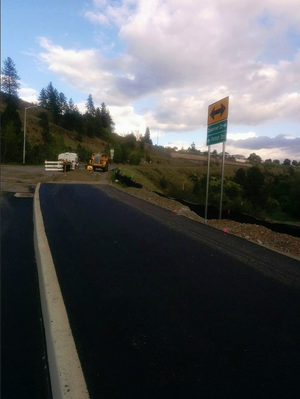Doomsday Hill will be open for Bloomsday, not Spokefest
As I reported in today's paper, a major renovation of Pettet Drive, otherwise known as Doomsday Hill, won't change the Bloomsday course this weekend, but it will prevent cyclists from pedaling up the dreaded hill this September for Spokefest.
A few extra details (and maps!) of the work and how it will affect things.
First, as I wrote last fall, the vehicle lanes of Pettet will tighten to allow for the paved, multiuse trail (part of the Centennial Trail) on the river-facing side of the road. Currently, Pettet Drive is 42 to 44 feet wide between curbs, which includes a bike lane in each direction. The new stretch of the Centennial Trail will be 14 feet wide and separate from traffic. Travel lanes on Pettet will be reduced to 12 feet each.
The picture at the top of the post, which I grabbed from the Spokane Bicycle Advisory Board's Facebook page, shows the beginning of the new path and road.
But adding a great trail isn't the reason for the work, but simply a benefit. Marlene Feist, who works for the city's utilities department, wrote a blogpost describing the real work going on underground:
In some parts of the City, wastewater and stormwater sewers are linked together and during periods of heavy rain or rapid snowmelt, these pipes can become overwhelmed and overflow to the river. Tanks like this store the excess water until the storm surge subsides and the water can be sent to the Riverside Park Water Reclamation Facility for treatment.
All of the work is part of the City’s Cleaner River Faster initiative. The City is investing more than $300 million in projects to improve water quality in the Spokane River.
The Cleaner River Faster initiative also encourages the City to include above-ground benefits when completing underground infrastructure work. These projects include new trail connections, notably a new separated paved pedestrian and bike trail on the river side of Doomsday Hill.
And here's a handy map, courtesy of the city:
Lastly, Bloomsday is not affected, but Spokefest is, as today's story showed. But how? Well, here's another fantastic map:
Notice the section of the course that goes along Downriver and then up to Northwest Boulevard. That's the detour. Instead of heading up Doomsday, cyclists will be pushed up, and have to push themselves up, T.J. Meenach Drive, which is notably steeper. A lane on T.J. Meenach and Northwest will be closed to vehicular traffic, helping the nerves of the weary cyclists.
Questions? Ask in the comments, or write me at nickd@spokesman.com.



